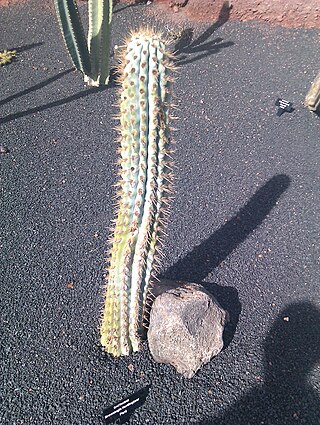
Acanthocalycium is a genus of cactus consisting of several species from Argentina, Bolivia, Brazil, Paraguay and Uruguay. The taxon name comes from Greek akantha and kalyx, which refers to the spines on the floral tubes.

Gymnocalycium, commonly called chin cactus, is a genus of about 70 South American species of cactus. The genus name Gymnocalycium refers to the flower buds bearing no hair or spines. In a 2023 classification of the tribe Cereeae, it was placed as the only genus in the subtribe Gymnocalyciinae, having formerly been placed in the subtribe Rebutiinae.

Cleistocactus is a genus of flowering plants in the cactus family Cactaceae, native to mountainous areas - to 3,000 m (9,843 ft) - of South America. The name comes from the Greek kleistos meaning closed because the flowers hardly open.

Thelocactus is a genus of flowering plants in the cactus family Cactaceae. Members of the genus are native to the arid lands of Central and Northern Mexico.

Brasilicereus is a genus of cacti known only from east Brazil and comprising three species.

Samaipaticereus is a monotypic genus of cactus containing the sole species Samaipaticereus corroanus. It is known only from East Andean Bolivia and Peru.

Rapicactus mandragora, synonym Turbinicarpus mandragora, is a species of plant in the family Cactaceae.

Turbinicarpus pseudopectinatus is a species of plant in the family Cactaceae.

Cleistocactus morawetzianus is a species of columnar cactus in the genus Cleistocactus, endemic to Peru.

Acanthocalycium thionanthum is a species of Acanthocalycium from Argentina.

Oreocereus trollii, commonly known as the Old Man of the Andes cactus, is a species of cacti native to Argentina and Bolivia. Though listed as Least Concern by the IUCN, the plant is collected extensively, and in some areas is threatened.

Neoraimondia arequipensis, also known as Neoraimondia macrostibas, is a tree-like cactus native to western Peru. It was first described in 1835 as Cereus arequipensis.

Neoraimondia herzogiana is a tree-like cactus native to Bolivia.

Xiquexique gounellei is a species of plant in the genus Xiquexique of the cactus family. Common names include "Alastrado", "Chique-Chique", "Xique-Xique" and "Xique-Xique das Pedras".

Browningia hertlingiana is a species of Browningia found in Peru.

Pachycereus weberi is a columnar cactus plant native to Mexico.

Loxanthocereus sextonianus is a species of Loxanthocereus found in Peru.
Pelecyphora zilziana is a species of flowering plant in the family Cactaceae, native to Mexico.

Brasilicereus phaeacanthus is a species of Brasilicereus found in Brazil.

Micranthocereus purpureus is a species of Micranthocereus found in Brazil.




















